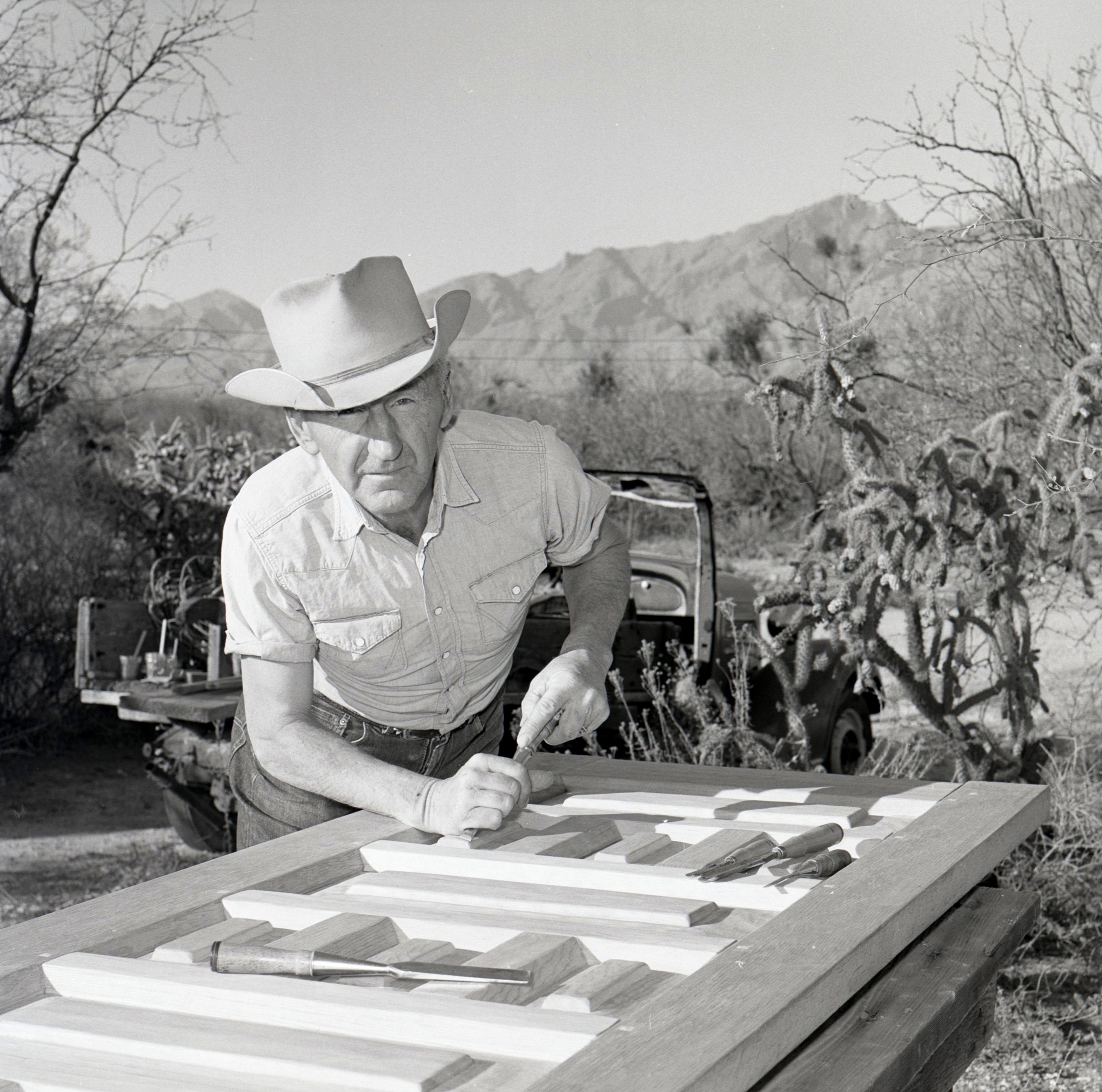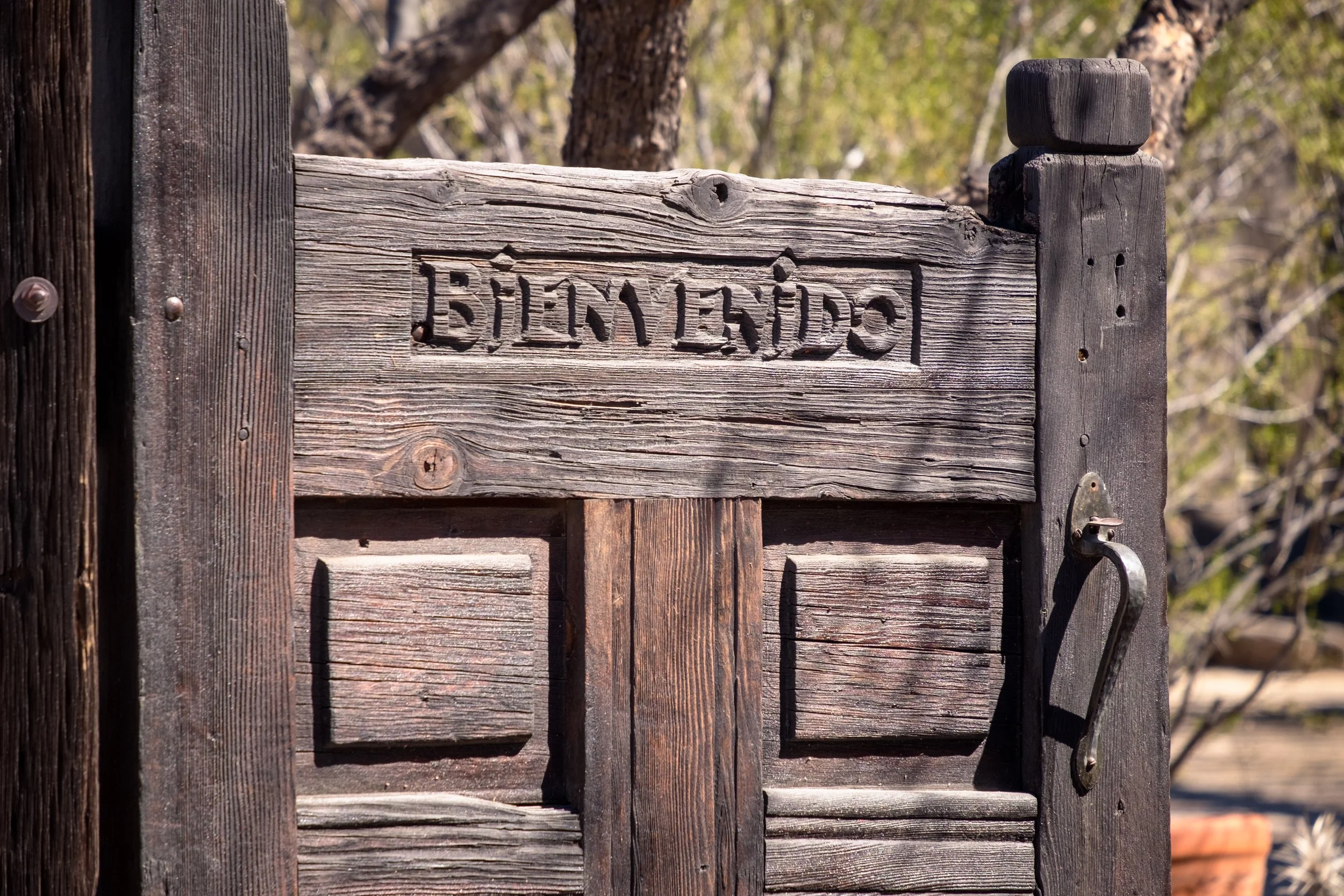Artists and Craftsman

Charles Bolsius meticulously infused the property with exquisite craftsmanship and elegant woodwork. Beyond his personally hand-carved doors, the house showcases an extensive collection of Bolsius paintings and furniture. Charles seamlessly integrated other masterful works into the house, including forged iron handles and light sconces crafted by Pedro Carreon.
This artistic tradition continues with the contributions of skilled local craftsmen, such as woodworker Eric Pena, painter Jenna Tomasello, ironworker Chris Nast, and ironworker Doug Thompson. The 1985 addition, carefully designed by John Hartshorn Carson, complements the house's aesthetic. Additionally, the house boasts a remarkable collection of early 20th-century artworks by renowned artists like Hurlstone Fairchild, Pete Martenez, Gerry Peirce, Al Romo, and others.

Craftsman.
Pedro Carreon, credited for the front door ornamental ironwork and main bedroom door latch, as well as the iron light sconces in the main bedroom and dining room c. 1960, brought his exceptional skills from Hermosillo, Sonora. Carreon's legacy includes a prolific career in southern Arizona, marked by his work for Elizabeth Hazen's La Forja Azul and contributions to the Montiel Mexican Art factory.
Jenna Tomasello, commissioned in 2023, added her touch to the west bathroom's glass windows, drawing inspiration from Tucson designer Leionne Salter. Tomasello's journey as an artist evolved from diverse experiences, including conventional house painting, murals, and collaborations with skilled craftsmen.
Chris Nast, born in 1975, a Tucson native, transitioned to a midlife career in welding and fabrication in 2011. Guided by mentor Tom Bredlow, Nast's hand-forged ironwork, commissioned in 2023 for Bolsius House, reflects technical prowess and a commitment to the tradition of Old Fort Lowell.
Doug Thompson, a Tucson native since 1958, has left an indelible mark on the city's artistic landscape through his high-end metalwork. His ornamental iron handrail in the main bedroom, crafted in 2010, showcases his expertise, which extends beyond metal structures to mentoring local craftsmen and students.
Bolsius House has been curated with an outstanding collection of paintings and design work by Charles Bolsius and Southern Arizona Artists from the early 20th Century.
Pete Martinez (1894–1970) was an American cowboy artist celebrated for his expertise in drawing, printmaking, and watercolor, with a particular focus on capturing the essence of Arizona desert landscapes and cowboy life. Born in Porterville, California, Martinez grew up near Deer Creek, where he followed in his father's footsteps as a cowboy after his untimely death when Martinez was just twelve years old. Excelling in horsemanship, Martinez's skills were noticed by racehorse owners, leading him to also become a renowned rodeo star. Encouraged by his peers, Martinez began depicting ranch life through art, eventually pursuing formal training in San Francisco and later Philadelphia and New York. His talent and passion for art never eclipsed his love for the cowboy lifestyle, as he continued to participate in rodeos to supplement his income. Settling in Tucson in 1932, Martinez's art became infused with the rugged beauty of the Southwest, immortalizing cowboy culture in his illustrations and murals, including the renowned Tap Room Bar mural at the Hotel Congress. Martinez's legacy lives on, his artwork providing a vivid portrayal of Tucson and the Western frontier long after his passing in 1971.
Gerry Peirce (1900–1968), an American artist renowned for his mastery of watercolor and printmaking, particularly dry point plate etchings, left an indelible mark on the art world with his ethereal depictions of Arizona's desert landscapes, cacti, and mountains. Born in Jamestown, New York, Peirce honed his craft at the Cleveland School of Fine Arts and the Art Student's League in New York City. His artistic journey led him across diverse landscapes, from an isolated fishing village in Nova Scotia, where he delved into dry point etchings, to the French Quarter of New Orleans during the Depression, where he captured the essence of the city through prints and teaching. Traveling extensively throughout the United States and Cuba, Peirce settled in Philadelphia before finding his artistic home in Tucson, Arizona, where he established "The Print Room" studio in 1934. Inspired by the Sonoran desert's grandeur, his prints evolved to reflect the region's tonality and stark beauty. Collaborating with Stanford Stevens, he illustrated "Plants of Sun and Sand" in 1939, further solidifying his national recognition. Transitioning from etchings to watercolors, Peirce's work continued to evolve, culminating in the creation of the Gerry Peirce School of Art, a hub for artistic creativity in Tucson. His contributions to the art world earned him numerous accolades, including an honorary doctorate from St. Andrews University College of London. Peirce's legacy endures through his transformative art and cultural contributions, shaping the perception of the Southwest and solidifying Tucson as a vibrant artistic center.
Eric Pena, Eric Peña, born in Guanajuato, Mexico, in 1980, embarked on a journey that would define his expertise in craftsmanship and restoration. Despite schooling only up to the sixth grade, his determination led him to the United States at 18. His first job in Mesa, Arizona, involved laboring in the orange groves before transitioning to Southwest Windows and Doors in Tucson, where he honed his skills for four years fabricating products. Following this stint, Peña spent a decade with a wood flooring company, deepening his understanding of woodwork. Subsequently, he embarked on a transformative two-year journey under the tutelage of master wood maker Peter Baer, refining his craftsmanship to new heights. Armed with years of experience and a passion for restoration, Peña ventured into entrepreneurship, specializing in restoring historic properties in Tucson. His mastery spans cabinetry, tile work, and flawless finishes, exemplifying his dedication to preserving the architectural heritage of the region.
John Hartshorn Carson, born in 1945, enriched the Bolsius House with his 1985 addition. Carson's journey from the University of Arizona to his impactful career in architecture and fine arts is marked by significant projects, including historic preservation endeavors like the Barrio Viejo bakery building.
Art Collection.
Hurlstone Fairchild (1893-1966) was born in Danville, Illinois, and though his early years showed little inclination towards art, his career as a mining engineer led him to spend significant time in the desert. It was there that he developed a deep appreciation for the desert's beauty, particularly in Arizona, where he eventually settled. Despite lacking formal art training, Fairchild began capturing the allure of the desert landscapes through paintings and drawings. His talent quickly gained recognition, leading him to become known as an illustrator, writer, and painter of Southwest subjects, with a focus on the Grand Canyon. Alongside Ruth Warner and Vera Patterson, he co-founded the Gallery of Southwestern Art in Tucson, promoting art inspired by the region. Fairchild's artistic journey culminated in the publication of his book "Grand Canyon Sketches and Verse" in 1950, solidifying his influence on the cultural scene of the Southwest. Despite being self-taught, Fairchild's talent was honored with the title of "Fellow" by the Royal Scottish Academy, a rare achievement for an American artist. Through his work and dedication, Fairchild made a lasting impact on the artistic legacy of the Southwest and beyond.
Jack Van Ryder (1899 – 1967), an American cowboy and western artist, lived a life as colorful as his vivid artwork, which often drew inspiration from his adventurous experiences. Born on his father's ranch in Continental, Arizona, he spent his youth as a cowboy, roaming from the logging camps of Oregon to the rodeo circuits across the country. He served in various military units during World War I and World War II before returning to the West, where his passion for art blossomed alongside his rodeo fame. Venturing to Hollywood, he briefly worked as an extra before transitioning to art, eventually gaining recognition with his bold and emotional western landscape paintings, characterized by soft hues and expansive skies. His artistic journey led him from one-man shows in New York to commissions for murals at the American Museum of Natural History, and his work adorned galleries and museums nationwide. Despite his tumultuous personal life, marked by numerous marriages and adventurous escapades, including befriending Henry Ford and accompanying Charles Russell on painting expeditions, Van Ryder's legacy as both an artist and a cowboy endures, shaping romantic views of the American Southwest.
The collective contributions of these artists and craftsmen converge, creating a tapestry of art, history, and craftsmanship within the walls of Bolsius House, offering a unique and immersive experience for visitors..
Book a Stay
Staying at the Jacobson House is a connection with light and the rhythms of the deserts

